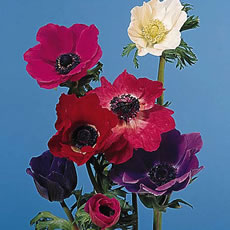anemone
Picture Source:California Cut Flower Commission
Popular Name: Anemone
Botanical Name and Pronunciation: Anemone coronaria (a-NEM-o-nee ko-ro-NAH-ree-a)
Common Name(s): Poppy Anemone, Windflower
Color(s): white, pink, red, magenta, burgundy, blue or purple
Form and Size: A graceful, cup-shaped flower with a pale green or black center. With only one bloom on each stem, the plant is perennial from tubers.
Vase Life: 3 - 7 days, sometimes longer
Availability: almost year-round
Care Instructions: Remove any foliage at the bottom, cut stems under water and place in fresh water with flower food. Keep vase full at all times. It is not recommended to place this flower in a vase with a daffodil, as the sap that a daffodil emits can be harmful to an anemone. Take care when handling, as ingestion can cause minor illness and frequent handling may cause skin irritation.
History and Usage: A member of the Ranunculaceae (buttercup) family, the anemone originates from the Mediterranean. The flowers that florists traditionally use are of the spring blooming coronaria variety whereas gardeners prefer to grow the smaller Japanese variety because they are hardier and have a longer blooming season. The Japanese flowers, which bloom from late summer into autumn, were first sent to England in 1844 by Robert Fortune, who saw them growing on Chinese tombs and thought they were a lovely ornamentation. Known as the windflower because it flourishes in high, windy terrain, its name comes from the ancient Greek word anemos, which means wind. Hence, the Greeks believed it was a favorite flower of Zephyr, the god of the west wind. The name may also be derived from the word Naamen, which is Persian for the Greek Adonis because a romantic legend is associated with its beautiful blossoms. Aphrodite, the Greek goddess of love, fell in love with the young Adonis. She tried to protect Adonis by hiding him in the underworld, but she was forced to share him with Persephone, the goddess of the underworld. One day while Adonis was hunting a huge boar, the wounded animal turned on him and gored him. Aphrodite held him in her arms as he lay dying. Some legends say Anemone flowers sprang up from the tears Aphrodite wept, and others say that they sprang up from the blood of the dying Adonis. Hence, as Diana Wells so poignantly explains in her book 100 Flowers and How They Got Their Names (Algonquin Books of Chapel Hill, 1997), it became the symbol of protective love that could not protect and of adventurous youth and beauty that challenged life, and lost. Later in Christian Medieval legends it was said to have sprung up from the blood Christ shed on the cross.
Points of Interest: Its common relatives are delphinium, larkspur, columbine, peony, buttercup and ranunculus. There is speculation, too, that anemones were the lilies of the field to which Christ refers in the gospel of St. Matthew (6: 28).
Popular Name: Anemone
Botanical Name and Pronunciation: Anemone coronaria (a-NEM-o-nee ko-ro-NAH-ree-a)
Common Name(s): Poppy Anemone, Windflower
Color(s): white, pink, red, magenta, burgundy, blue or purple
Form and Size: A graceful, cup-shaped flower with a pale green or black center. With only one bloom on each stem, the plant is perennial from tubers.
Vase Life: 3 - 7 days, sometimes longer
Availability: almost year-round
Care Instructions: Remove any foliage at the bottom, cut stems under water and place in fresh water with flower food. Keep vase full at all times. It is not recommended to place this flower in a vase with a daffodil, as the sap that a daffodil emits can be harmful to an anemone. Take care when handling, as ingestion can cause minor illness and frequent handling may cause skin irritation.
History and Usage: A member of the Ranunculaceae (buttercup) family, the anemone originates from the Mediterranean. The flowers that florists traditionally use are of the spring blooming coronaria variety whereas gardeners prefer to grow the smaller Japanese variety because they are hardier and have a longer blooming season. The Japanese flowers, which bloom from late summer into autumn, were first sent to England in 1844 by Robert Fortune, who saw them growing on Chinese tombs and thought they were a lovely ornamentation. Known as the windflower because it flourishes in high, windy terrain, its name comes from the ancient Greek word anemos, which means wind. Hence, the Greeks believed it was a favorite flower of Zephyr, the god of the west wind. The name may also be derived from the word Naamen, which is Persian for the Greek Adonis because a romantic legend is associated with its beautiful blossoms. Aphrodite, the Greek goddess of love, fell in love with the young Adonis. She tried to protect Adonis by hiding him in the underworld, but she was forced to share him with Persephone, the goddess of the underworld. One day while Adonis was hunting a huge boar, the wounded animal turned on him and gored him. Aphrodite held him in her arms as he lay dying. Some legends say Anemone flowers sprang up from the tears Aphrodite wept, and others say that they sprang up from the blood of the dying Adonis. Hence, as Diana Wells so poignantly explains in her book 100 Flowers and How They Got Their Names (Algonquin Books of Chapel Hill, 1997), it became the symbol of protective love that could not protect and of adventurous youth and beauty that challenged life, and lost. Later in Christian Medieval legends it was said to have sprung up from the blood Christ shed on the cross.
Points of Interest: Its common relatives are delphinium, larkspur, columbine, peony, buttercup and ranunculus. There is speculation, too, that anemones were the lilies of the field to which Christ refers in the gospel of St. Matthew (6: 28).

